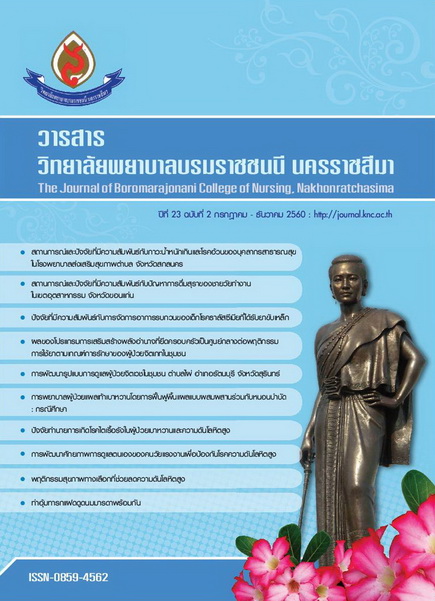การพยาบาลผู้ป่วยแผลเท้าเบาหวานโดยการฟื้นฟูพื้นแผลแบบผสมผสานร่วมกับหนอนบำบัด: กรณีศึกษา
คำสำคัญ:
diabetic foot ulcers, maggot therapy, Manuka honey, แผลเท้าเบาหวาน, หนอนบำบัด, น้ำผึ้งมานูก้าบทคัดย่อ
บทคัดย่อ
แผลเท้าเบาหวานเป็นสาเหตุสำคัญที่ทำให้ผู้ป่วยต้องเข้ารับการรักษาในโรงพยาบาลส่วนใหญ่เกิดจากไม่สามารถควบคุมระดับน้ำตาลในเลือดได้ทำให้แผลติดเชื้อลุกลามอย่างรวดเร็วหากได้รับการดูแลรักษาที่ไม่ถูกต้องผู้ป่วยจะต้องนอนในโรงพยาบาลนานขึ้น อาจรุนแรงจนต้องตัดเท้าได้และค่าใช้จ่ายสูงมากขึ้น ซึ่งส่งผลกระทบต่อผู้ป่วยทั้งด้านร่างกายจิตใจคุณภาพชีวิตเศรษฐกิจและสังคม ดังนั้นการดูแลแผลมีหลักการที่สำคัญคือการดูแลพื้นของแผลอย่างมีประสิทธิภาพ ประเมินการหายของแผลอย่างสม่ำเสมอกำจัดเนื้อตายเพื่อลดการขัดขวางกระบวนการหายของแผลและส่งเสริมปัจจัยที่ช่วยในกระบวนการหายของแผลเช่นความชุ่มชื้นและสภาพที่เหมาะสมแก่การเจริญของเนื้อเยื่อใหม่
ในการศึกษาครั้งนี้มีวัตถุประสงค์เพื่อศึกษาวิธีการที่ดีสำหรับการดูแลพื้นแผลแบบผสมผสานโดยใช้หนอนบำบัดแผลชนิด wet และ dry gangreneวิธีดำเนินการศึกษาใช้รูปแบบการศึกษาเหตุการณ์เฉพาะ (situation analysis)ใช้วิธีการคัดเลือกกรณีที่จะศึกษาอย่างชัดเจน (comprehensive sampling) และกำหนดกลุ่มตัวอย่างที่มีลักษณะเฉพาะตัว (typical case sampling) ได้ศึกษาเปรียบเทียบผู้ป่วยที่ได้รับการฟื้นฟูพื้นแผลด้วยหนอนบำบัดผสมผสานกับวิธีการอื่นๆ โดยรายแรกพบ infected DM foot ลักษณะ wet gangrene plan major amputation รายที่ 2 พบ DM foot ลักษณะ dry gangrene plan minor amputation เมื่อไม่ตอบสนองต่อแนวทางการรักษาทางการแพทย์ พยาบาลจึงใช้วิธีหนอนบำบัด (maggot therapy) 1ชุดการรักษา (9 วัน) และใช้น้ำผึ้งมานูก้าในการสร้างความชุ่มชื้นต่อจนกระทั่งแพทย์สามารถทำผิวหนังปะปลูกได้ (skin graft) โดยไม่ถูกตัดเท้าในรายที่ 1 ซึ่งใช้เวลารักษาตัวในโรงพยาบาล 72 วัน รายที่ 2 ไม่จำเป็นต้องทำผิวหนังปะปลูกโดยไม่ถูกตัดนิ้วเท้า รักษาตัวในโรงพยาบาล 53 วัน
การใช้หนอนบำบัดเป็นการแพทย์ทางเลือกต้องได้รับความยินยอมทั้งทีมผู้รักษาและผู้ป่วยเนื่องจากเป็นทางเลือกด้านการรักษาที่มีค่าใช้จ่ายส่วนตัวของผู้ป่วยและครอบครัวน้ำผึ้งมานูก้าเป็นวัสดุทางการแพทย์ที่ช่วยส่งเสริมการหายของแผลได้ในพื้นแผลที่เหมาะสม
คำสำคัญ: แผลเท้าเบาหวาน, หนอนบำบัด, น้ำผึ้งมานูก้า
Nursing Care of Wound Bed in Diabetic Foot Ulcers Integrated with Maggot Therapy: Case Study
Abstract
Diabetic foot ulcers are a major cause of hospitalization among diabetic patients. Most of them are unable to control their blood sugar level effectively, causing the infected wound to spread rapidly. Without proper maintenance, patients run high risks of amputation requiring long periods of hospitalization and incurring high medical costs. This greatly affects the patient physically, emotionally, their quality of life, and financial and social life. An important part of wound care is the efficient care of the wound bed, usually assessment, appropriated debridement and wound bed revival of tissue granulation.
This objective study compared maggot therapy for wound bed care in wet and dry gangrene. The type of case study used was situation analysis and comprehensive sampling. The purposeful sampling strategies used by typical case sampling were utilized. The first study was a patient with wet gangrene infected diabetic foot ulcers who was scheduled for major amputation. The second patient had dry gangrene diabetic foot ulcers who was scheduled for minor amputation if the wound did not respond to medical treatment. One course of maggot therapy (9 days) was started and followed with Manuka honey to keep the wounds moist. Finally, the findings found that the length of stay of the first patient was 72 days with his foot saved with skin grafting, and the length of stay of the second patient was 53 days, his big toe was saved without grafting. The suggestion that maggot therapy was used first as alternative treatment with the commitment of the patient and the care team, and, second, Manuka honey is appropriate for the wound bed.
Keywords: diabetic foot ulcers, maggot therapy, Manuka honey
ดาวน์โหลด
เผยแพร่แล้ว
ฉบับ
ประเภทบทความ
สัญญาอนุญาต
บทความที่ได้รับการตีพิมพ์เป็นลิขสิทธิ์ของ วารสารสุขภาพและการศึกษาพยาบาล ซึ่งดำเนินการโดยวิทยาลัยพยาบาลบรมราชชนนี นครราชสีมา
ข้อความที่ปรากฏในบทความในวารสารเล่มนี้เป็นความคิดเห็นส่วนตัวของผู้เขียนแต่ละท่านไม่เกี่ยวข้องกับกองบรรณาธิการวารสารสุขภาพและการศึกษาพยาบาล หรือวิทยาลัยพยาบาลบรมราชชนนี นครราชสีมา แต่อย่างใด ความรับผิดชอบองค์ประกอบทั้งหมดของบทความแต่ละเรื่องเป็นของผู้เขียนแต่ละท่าน หากมีความผิดพลาดใดๆ ผู้เขียนแต่ละท่านจะรับผิดชอบบทความของตนเองแต่ผู้เดียว







